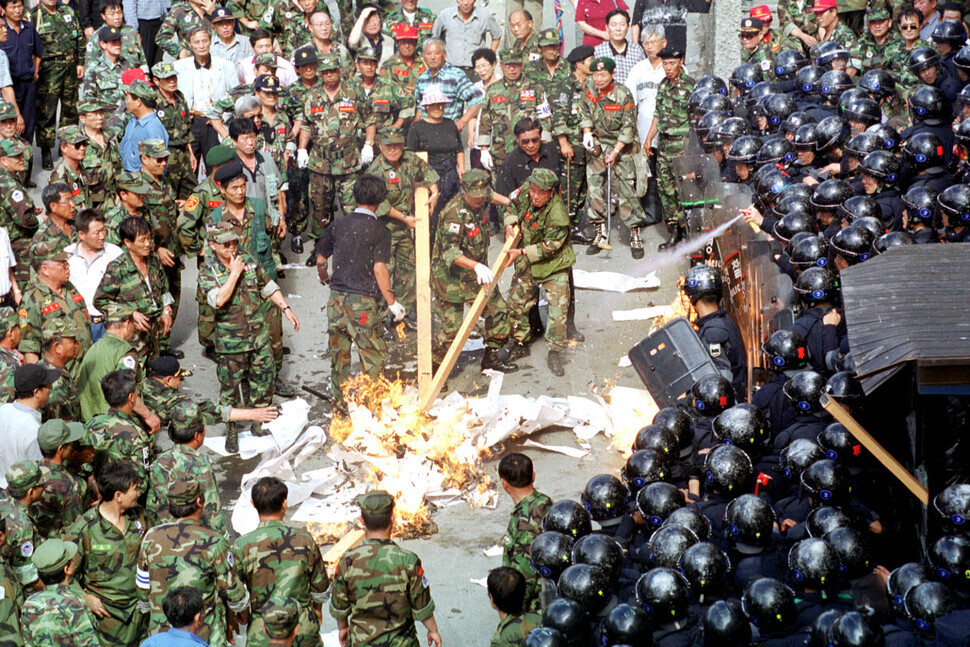hankyoreh
Links to other country sites 다른 나라 사이트 링크
Ruling on Korean atrocity in Vietnam comes 23 years after Hankyoreh 21’s exposé

The civilian massacres perpetrated by South Korean troops during the Vietnam War were first brought to light through reporting in the Hankyoreh 21 magazine in 1999.
The shocking report provoked enormous pushback. On June 27, 2000, more than 2,000 members of an association of Korean veterans harmed by Agent Orange in the Vietnam War occupied the street in front of the Hankyoreh office and tried setting the building on fire. Some of the veterans stormed into the office, trashing furniture and assaulting employees.
On Nov. 30, 2000, Koh Kyoung-tae — the Hankyoreh 21 reporter who had broken the story about the massacres — revealed the tragic events that had occurred in the villages of Phong Nhi and Phong Nhat through photographs and documents about the Korean troops’ massacres that the US National Archives Museum had declassified after 30 years.
Around ten years later, in January 2013 and February 2014, Koh returned to those villages in Vietnam to continue his reporting. The next year, in February 2015, he published what she had learned in a book titled “Feb. 12, 1968.”

Nguyen Thi Thanh, aged 63, a resident of Phong Nhi, came to Korea in 2015 on an invitation from the Peace Museum. She was the first Vietnam War massacre survivor to visit the country.
Then in April 2018, Nguyen Thi Thanh stood as a plaintiff in the People’s Tribunal on War Crimes by South Korean Troops during the Vietnam War, which was organized by Minbyun-Lawyers for a Democratic Society and the Korea-Vietnam Peace Foundation.
Former Supreme Court justice Kim Yeong-ran, who presided over the tribunal, ruled that Korea should pay damages to the plaintiffs and officially apologize to them to restore their honor and dignity.
After that, a Minbyun task force aimed at learning the truth about civilian massacres during the Korean War filed a damages lawsuit at the Seoul Central District Court on behalf of Nguyen Thi Thanh on April 21, 2020, asking the Korean government for around 30 million won.
“Just an acknowledgment of the civilian massacres from the South Korean government would ease the pain of the victims. I am one of many victims whose honor I hope will be restored,” Nguyen Thi Thanh said over video chat during a press conference at the time.
By Lee Woo-yun, staff reporter
Please direct questions or comments to [english@hani.co.kr]

Editorial・opinion
![[Editorial] Penalties for airing allegations against Korea’s first lady endanger free press [Editorial] Penalties for airing allegations against Korea’s first lady endanger free press](https://flexible.img.hani.co.kr/flexible/normal/500/300/imgdb/original/2024/0502/1817146398095106.jpg) [Editorial] Penalties for airing allegations against Korea’s first lady endanger free press
[Editorial] Penalties for airing allegations against Korea’s first lady endanger free press![[Editorial] Yoon must halt procurement of SM-3 interceptor missiles [Editorial] Yoon must halt procurement of SM-3 interceptor missiles](https://flexible.img.hani.co.kr/flexible/normal/500/300/imgdb/child/2024/0501/17145495551605_1717145495195344.jpg) [Editorial] Yoon must halt procurement of SM-3 interceptor missiles
[Editorial] Yoon must halt procurement of SM-3 interceptor missiles- [Guest essay] Maybe Korea’s rapid population decline is an opportunity, not a crisis
- [Column] Can Yoon steer diplomacy with Russia, China back on track?
- [Column] Season 2 of special prosecutor probe may be coming to Korea soon
- [Column] Park Geun-hye déjà vu in Yoon Suk-yeol
- [Editorial] New weight of N. Korea’s nuclear threats makes dialogue all the more urgent
- [Guest essay] The real reason Korea’s new right wants to dub Rhee a founding father
- [Column] ‘Choson’: Is it time we start referring to N. Korea in its own terms?
- [Editorial] Japan’s rewriting of history with Korea has gone too far
Most viewed articles
- 160% of young Koreans see no need to have kids after marriage
- 2Presidential office warns of veto in response to opposition passing special counsel probe act
- 3Hybe-Ador dispute shines light on pervasive issues behind K-pop’s tidy facade
- 4S. Korea “monitoring developments” after report of secret Chinese police station in Seoul
- 5Months and months of overdue wages are pushing migrant workers in Korea into debt
- 6OECD upgrades Korea’s growth forecast from 2.2% to 2.6%
- 7[Editorial] Penalties for airing allegations against Korea’s first lady endanger free press
- 8Inside the law for a special counsel probe over a Korean Marine’s death
- 9Japan says it’s not pressuring Naver to sell Line, but Korean insiders say otherwise
- 10S. Korea discusses participation in defense development with AUKUS alliance